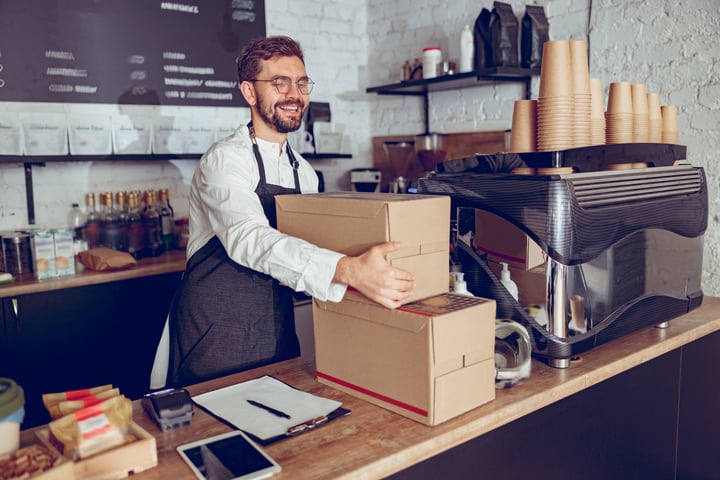
- Home
- Crunchtime Blog
- Inventory Without the Guesswork: How AI is Powering Restaurant Efficiency

Inventory Without the Guesswork: How AI is Powering Restaurant Efficiency
Learn how AI is helping restaurants optimize their inventory levels
Managing food costs continues to be a top focus for operators nationwide. One of the key strategies to accomplish this is to improve vendor orders, ensuring that each store optimizes stock levels with just the right amount of product to meet demand in each store.
AI has become a critical tool to help make this possible. Incorporating AI into predictive analytics is one of the most powerful use cases of AI for restaurants today. And the best part is that it is available for operators to leverage today, not five years from now. Applying machine learning to a restaurant’s forecast can help predict demand with a new level of accuracy and create smart recommendations about how much food to order.
That means no more guesswork about how much beef or chicken you need to order for the next week. The new standard for inventory management will be based on data-driven insights, not instinct.
AI helps eliminate guesswork, making it easier to plan for demand and place orders
Using AI in predictive analytics, the computer does the heavy lifting, analyzing your past sales to create an accurate prediction of your future sales. In fact, restaurants are seeing success already. Crunchtime customers have been able to predict their future sales within a dollar using AI Forecasting. Learn more about Crunchtime’s AI-powered forecasting here.

Why suggested ordering is a must-have for every modern restaurant operation
The days of guesswork are over. Restaurants can now operate smarter and faster with predictive analytics technology. And with a suggested order that is fueled by an AI forecast, you’ll be priming your operation for maximum success.
Here are the key benefits of using Suggested Ordering:
- Keep your inventory levels optimized at every store.
- Save money by reducing overstocking
- Reduce costly, unnecessary waste
- Keep your customers happy and returning by never running out of menu items
- Save your team significant time – place orders faster with an accurate recommendation
- Easy to use for every manager at every level – With minimal training required, any manager can place a great order, whether they’ve been on the job for two weeks or ten years.
Is it time to improve your restaurant's approach to ordering?
Here are some common challenges that might signal it's time to take a look at your processes:
- Unpredictable Demand – Restaurant demand is historically difficult to predict, which in turn makes it difficult to order the right quantities of food. Customer preferences are changing rapidly with to-go orders rising in popularity and other factors like weather are difficult to predict.
- Substitutions – While shortages have eased in some ways, substitutions still remain the norm. Dealing with substitutions can quickly complicate the ordering process and result in paying higher prices and ordering the wrong items.
- Broken Process or System for Ordering – Placing vendor orders can be time consuming and complicated, not just for the manager in the store but for your accounts payable teams as well. If you use an inventory system or process that does not provide clear visibility around contract prices you can expect this to quickly become convoluted.
- Turnover Creates Knowledge Gaps – Placing a precise vendor order with the right quantities is a skill that many managers learn over time, and it often requires additional training. If a restaurant is experiencing a high rate of turnover or lacks resources for training, the ordering processes will likely suffer, eventually impacting profitability.
- Over-Ordering and Waste – Many restaurant professionals still make an educated guess when placing orders, but this often leads to costly waste from spoilage and hurts a restaurant's bottom line. If your operation is running on tight margins, keeping your cash flow tied up in inventory is not a good strategy for long-term growth.
- Under-ordering – Running out of a menu item can negatively impact the customer experience.
The bottom line: optimizing inventory isn’t just a nice-to-have—it’s a must.
AI-powered predictive analytics are transforming how restaurants forecast demand, place orders, and manage stock across every location. By reducing waste, preventing shortages, saving time, and enabling smarter decisions, suggested ordering is quickly becoming the new standard. Operators no longer have to rely on gut instincts or outdated methods.
With tools like Crunchtime’s AI forecasting, every manager, regardless of experience, can place precise, data-driven orders that improve profitability and guest satisfaction. The future of restaurant inventory management is here—and it’s powered by AI.
Ready to learn more?
Let’s get in touch to talk about tools and systems that reduce errors and boost accuracy for restaurants.
Share this post
Related


Introducing Weather-Driven AI Forecasting for Restaurants



